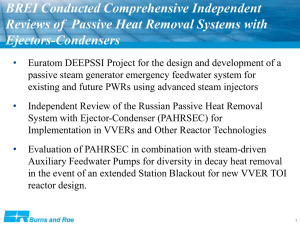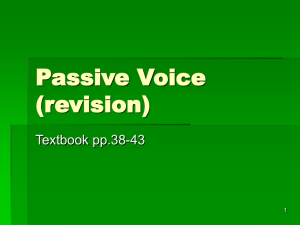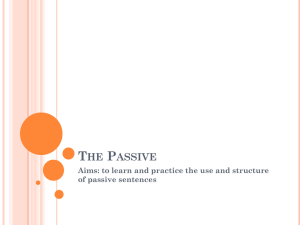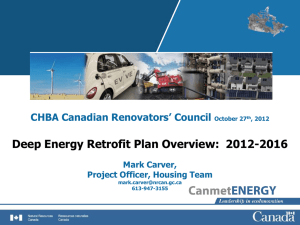Beyond Sustainability Surviving Peak Oil & Climate Change
advertisement
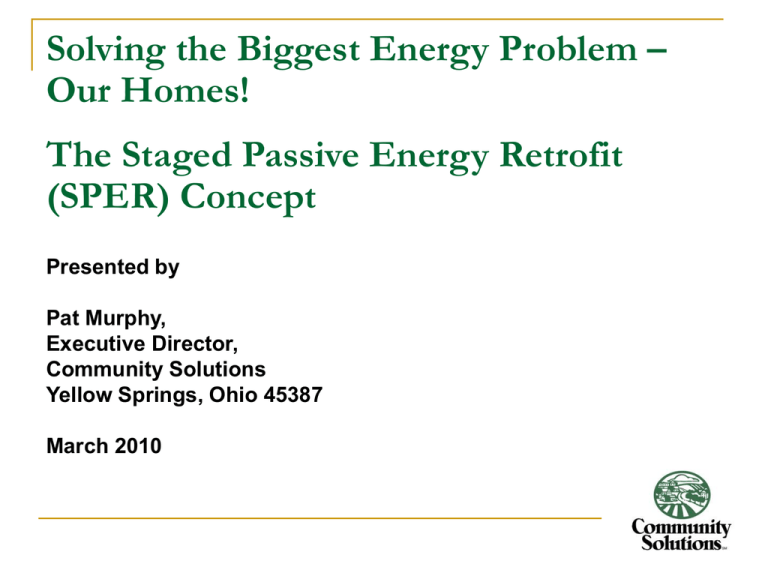
Solving the Biggest Energy Problem – Our Homes! The Staged Passive Energy Retrofit (SPER) Concept Presented by Pat Murphy, Executive Director, Community Solutions Yellow Springs, Ohio 45387 March 2010 U.S. Energy Consumption Breakdown Energy for U.S. homes alone greater than world average use 49% of U.S. energy is used in buildings 39% operating, 10% embodied (building) energy U.S. has about 115 million residences (80 million houses) New building ~1.0 million units/yr. typically U.S. Homes – Size Matters U.S. home size 2008 – 2,200 sq. ft. 1959 – 1,000 sq. ft. Per capita square foot 1950 – 260 sq. ft. 2008 – 800 sq. ft. U.S. residences twice as large as those in Europe or Japan Use 2.4 times energy U.S. citizens want big homes U.S. Energy Use in Buildings Building energy use is understood very well Techniques and products exist for much better efficiency Weatherization programs provide experience for existing homes “Green Building” – Too Little, Too Late LEED and EnergyStar Ineffective Green programs reduce energy use by 15-20% Need 80-90% “Green buildings” are only about 5% of new construction Less than 1% of existing homes are “green” after 10 years Will take decades to turn over the building stock By then it will be too late! Can Building Energy Use be Cut by 90%? There is a technology that can do this The German “PasivHaus” or Passive House Basis of the technology “Super insulation” – R40-60 “Super air-tight” “Super windows” (triple-glazed) – R7 And a new device – Heat Recovery Ventilator House can’t “breath” (which means leak) anymore “Thick” Tight Envelope – The Core Concepts Based on SuperInsulated House of 1970s (Shurcliff) Early version of German “Passive House” 13th Annual Passive House Conference Held April 2009 in Frankfurt, Germany 1,200 attendees from around world 100 presenters Tours of homes/schools About 20,000 passive houses/buildings to date 18 years since first one was built – a maturing technology Great windows, heat exchangers, insulation, sealants Achieving 90% heating/cooling energy reduction Housing Revolution – Passive House Germany energy reduction target – 90% Realized most energy consumed is in buildings Defined passive building as energy used/sq. ft. Passive houses have no whole house heating systems – small backup units only Passive House being codified in German laws Germany the leading nation in wind and solar And in super efficient buildings! Passive House History/Description Continuation of U.S. 1970/80s super-insulated movement Germany picked up U.S. work and developed it further U.S. lost Interest 4 Passive House conferences held in U.S. to date The Passive House – U.S. Status Fundamental spec – use 90% less heating/cooling energy Germans are teaching U.S. builders 20+ U.S. versions built or in process Super-insulated – thick shell 14-inch walls Corresponding thick floor/roofs Very small heating system or AC Uses heat exchanger for ventilation Costs 10% more than conventional house Some Passive House Elements Illustrated Passive House Addresses Heating/Cooling Remainder Is Appliances and Lifestyle Eliminates leaks: 20% of energy costs New windows next big savings Thick, tight “building envelope” Ductwork in the conditioned space Better appliances found in Europe Will appear in the U.S. at some point Still need habit changes Passive House – Key Future Technology Heating/cooling/ventilation Envelope/windows/air tight Heat exchanger for ventilation Addresses about half the energy use Appliances are improving continuously Sun Frost refrigerators On-demand hot water heaters Plug loads can be managed Some habit change also needed All together will provide 80-90% reduction by 2050 But!!! This Is for New Homes New Passive Houses cost 10% more Passive House retrofits cost 40-50% of new building costs Easy to build new – hard to retrofit the old Retrofitting very labor intensive The good news – retrofits can obtain 90% energy savings There are many people trying retrofits Need leading-edge people Maria Everhart – “In any area of social change, someone has got to go first” A recent Passive Retrofit – The Carriage House Carriage House Retrofit – 2008 Approximately 1,000 square feet 100-year-old Carriage House Foundation and Floors Floors – vapor-barrier, 2’’ rigid foam, 7.5” floor joists, fiberglass Insulation = R30+ (code is R11) Vertical 2’’ rigid insulation on foundation walls Reduce ground heat loss Walls, Ceilings and Roofs Walls – double stud, 9 – 14 inches thick (R30 – R40) Ceiling/roof – dense pack insulation R40+ (code is R30) High-performance doors and windows Retrofit Building Energy Savings and $$ Wide range of estimates to redo all homes 115 million residence @ $60,000 + is $7 trillion. Far cheaper than paying fuel bills – e.g. 2010 to 2050 (40 years) Save 10 BOE yearly– estimate $200 BOE eqv. in 2012+ $2,000 yearly for 40 years = $80,000 Life cycle analysis shows this is a win-win situation Culture might change to 1950s values – homeowners do work Still a new concept is needed Staged Passive Energy Retrofitting – SPER SPER Retrofitting Idea may have originated with Linda Wigington of ACI The “1000 Home Challenge” Effort – 2007 Department of Energy made big change in 2009 De-emphasis on Building America Program Initiated the Retrofit for Recovery Program University of Dayton and Community Solutions formed Yellow Springs Energy Partnership to study energy use Local companies formed in Yellow Springs and Troy, Ohio DOE Strategic Plan for Recovery Through Retrofit Addresses Three Problems Market Barrier 1: Consumers need reliable home retrofitting information to make informed decisions Solution 1: We must provide straightforward and credible information to American homeowners on the costs and benefits of home energy retrofits Market Barrier 2: The costs of home retrofit projects are beyond the average homeowner’s budget Solution 2: We must make it easy for homeowners to identify and access home energy retrofit financing tools and products Market Barrier 3: Increase the number of skilled workers and green entrepreneurs to successfully expand efficiency retrofit programs on a national scale Solution 3: Mobilize a skilled national energy retrofit workforce and expand good, green job opportunities for all American workers Community Solutions Prepared Response Wide range of partners Community Solutions (Yellow Springs non-profit), Yellow Springs energy audit company, University of Dayton Building Energy Center, Troy, Ohio construction company Began working in anticipation of winning the award Decided to form a company regardless of the award Idea looked better and better Key partner provided breakthrough ideas Staged retrofitting – visit home multiple times over years Low-, middle- and high-hanging fruit picked over a decade Bring the mass production factory to the neighborhood SPER Key Factors of Success Cut labor costs in half by innovation Use factory techniques in the home neighborhood Build a long-term relationship with homeowner Become their “energy reduction” utility Review their usage – call when something happens Provide financing – repayment from lower energy bills Upgrade the home in stages to meet 2050 needs Using low-cost technologies that will appear Use Passive House technology in later stages as technology gained from new builds decreases cost Summary Passive building technology proven – goes back to 1970s Different than green building with its marginal energy savings Focus is on deep energy reductions Costs have been tested – 10% more for new, 40-50% cost of new for retrofit Government now understands need to retrofit Early adopters (including CS) preparing the examples Building companies seeing the opportunity Innovative finance ideas coming Could actually meet 90% reduction by 2050 with political will



